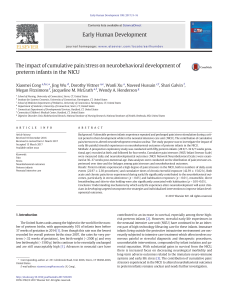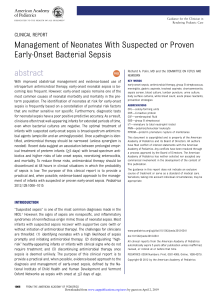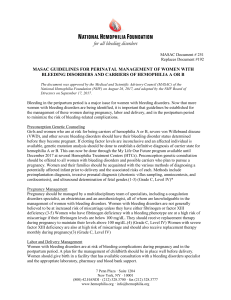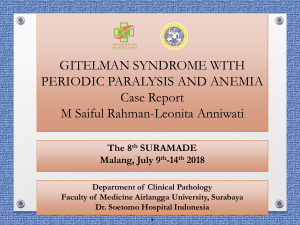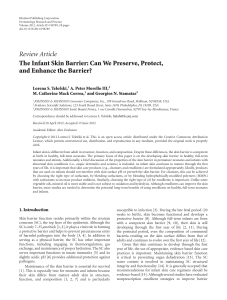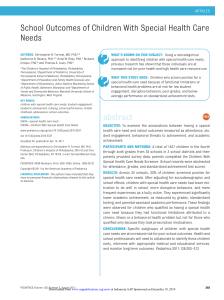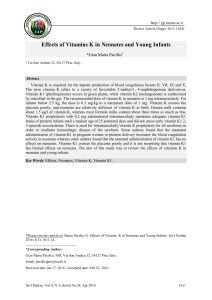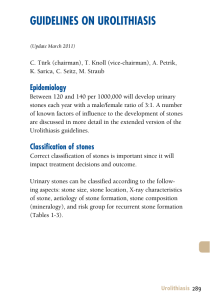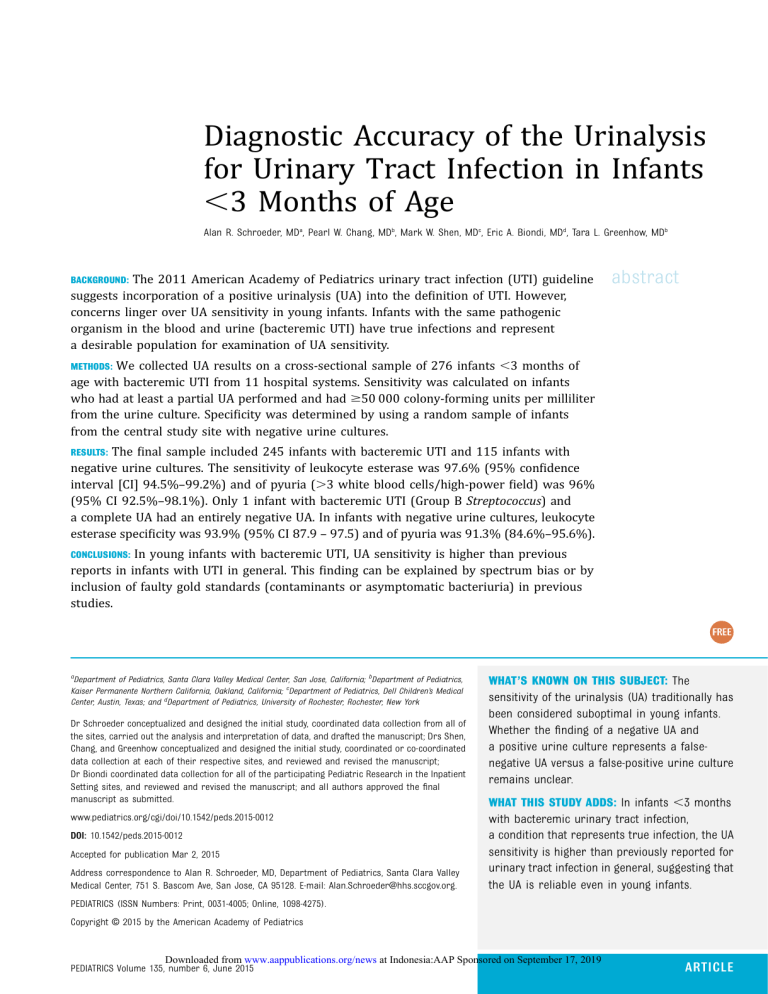
Diagnostic Accuracy of the Urinalysis for Urinary Tract Infection in Infants ,3 Months of Age Alan R. Schroeder, MDa, Pearl W. Chang, MDb, Mark W. Shen, MDc, Eric A. Biondi, MDd, Tara L. Greenhow, MDb The 2011 American Academy of Pediatrics urinary tract infection (UTI) guideline suggests incorporation of a positive urinalysis (UA) into the definition of UTI. However, concerns linger over UA sensitivity in young infants. Infants with the same pathogenic organism in the blood and urine (bacteremic UTI) have true infections and represent a desirable population for examination of UA sensitivity. BACKGROUND: abstract We collected UA results on a cross-sectional sample of 276 infants ,3 months of age with bacteremic UTI from 11 hospital systems. Sensitivity was calculated on infants who had at least a partial UA performed and had $50 000 colony-forming units per milliliter from the urine culture. Specificity was determined by using a random sample of infants from the central study site with negative urine cultures. METHODS: The final sample included 245 infants with bacteremic UTI and 115 infants with negative urine cultures. The sensitivity of leukocyte esterase was 97.6% (95% confidence interval [CI] 94.5%–99.2%) and of pyuria (.3 white blood cells/high-power field) was 96% (95% CI 92.5%–98.1%). Only 1 infant with bacteremic UTI (Group B Streptococcus) and a complete UA had an entirely negative UA. In infants with negative urine cultures, leukocyte esterase specificity was 93.9% (95% CI 87.9 – 97.5) and of pyuria was 91.3% (84.6%–95.6%). RESULTS: In young infants with bacteremic UTI, UA sensitivity is higher than previous reports in infants with UTI in general. This finding can be explained by spectrum bias or by inclusion of faulty gold standards (contaminants or asymptomatic bacteriuria) in previous studies. CONCLUSIONS: a Department of Pediatrics, Santa Clara Valley Medical Center, San Jose, California; bDepartment of Pediatrics, Kaiser Permanente Northern California, Oakland, California; cDepartment of Pediatrics, Dell Children’s Medical Center, Austin, Texas; and dDepartment of Pediatrics, University of Rochester, Rochester, New York Dr Schroeder conceptualized and designed the initial study, coordinated data collection from all of the sites, carried out the analysis and interpretation of data, and drafted the manuscript; Drs Shen, Chang, and Greenhow conceptualized and designed the initial study, coordinated or co-coordinated data collection at each of their respective sites, and reviewed and revised the manuscript; Dr Biondi coordinated data collection for all of the participating Pediatric Research in the Inpatient Setting sites, and reviewed and revised the manuscript; and all authors approved the final manuscript as submitted. www.pediatrics.org/cgi/doi/10.1542/peds.2015-0012 DOI: 10.1542/peds.2015-0012 Accepted for publication Mar 2, 2015 Address correspondence to Alan R. Schroeder, MD, Department of Pediatrics, Santa Clara Valley Medical Center, 751 S. Bascom Ave, San Jose, CA 95128. E-mail: [email protected]. WHAT’S KNOWN ON THIS SUBJECT: The sensitivity of the urinalysis (UA) traditionally has been considered suboptimal in young infants. Whether the finding of a negative UA and a positive urine culture represents a falsenegative UA versus a false-positive urine culture remains unclear. WHAT THIS STUDY ADDS: In infants ,3 months with bacteremic urinary tract infection, a condition that represents true infection, the UA sensitivity is higher than previously reported for urinary tract infection in general, suggesting that the UA is reliable even in young infants. PEDIATRICS (ISSN Numbers: Print, 0031-4005; Online, 1098-4275). Copyright © 2015 by the American Academy of Pediatrics Downloaded from www.aappublications.org/news at Indonesia:AAP Sponsored on September 17, 2019 PEDIATRICS Volume 135, number 6, June 2015 ARTICLE The sensitivity of the urinalysis (UA) for the diagnosis of urinary tract infection (UTI) in children generally has been reported to be 75% to 85%.1–6 Because of this suboptimal sensitivity, the urine culture is considered to be the gold standard for the diagnosis of UTI. However, the findings of a positive urine culture in a patient with a negative UA also may reflect a false-positive urine culture due to asymptomatic bacteriuria or contamination.7–10 The 2011 American Academy of Pediatrics’ (AAP) UTI guideline suggests that the diagnosis of UTI should require an abnormal UA in addition to a positive urine culture.4 However, these guidelines do not include infants ,2 months, and young infants with a negative UA and a positive urine culture are generally considered to have UTI.11–13 Bacteremic UTI represent a unique and desirable condition in which to assess the sensitivity of the UA. Infection with the same organism in the blood and urine renders contamination or asymptomatic bacteriuria extremely unlikely, thereby minimizing the probability that the urine culture represents a false positive. The aim of this study was to calculate the sensitivity of the UA in a multicenter sample of infants ,3 months with bacteremic UTI. UA specificity was calculated by using a separate sample of similar-aged infants with negative urine cultures. METHODS Setting A multicenter database of infants ,3 months with bacteremic UTI was assembled to analyze management and outcomes for this condition. This investigation included 276 infants from 20 hospitals at 11 hospital systems (see Acknowledgments) between 1998 and 2013. The central site for the study was Santa Clara Valley Medical Center, in San Jose, CA. All sites had existing databases that included infants with bacteremic UTI. Each site obtained additional independent institutional review board approval for this study. Informed consent was waived. Subjects Infants were included if they were ,3 months of age and had the same pathogenic organism isolated from blood and urine. The primary aim of the initial investigation was to examine parenteral antibiotic duration and outcomes. Therefore, infants were excluded if they had major comorbidities (defined as neuromuscular conditions such as spina bifida, previous urologic surgery other than circumcision, or immunodeficiency), if they were managed in the ICU, or if they had indwelling urinary or central venous catheters at the time the cultures were drawn. For this secondary analysis, infants were excluded if no UA was performed or if the urine culture grew ,50 000 colonyforming units/milliliter (CFU/mL), the AAP threshold for UTI.4 However, UA findings from this subgroup are presented. Data Collection and Variables Bacteremic UTIs at each site were originally identified by using existing microbiology databases. Site investigators reviewed charts by using a protocol specifically designed for this study. Data on specific components of the UA (white blood cells/high-power field [WBC/HPF], bacteria, nitrites, leukocyte esterase [LE]) were collected for each infant. To avoid verification bias, infants with partial UA results were included. Given that the terminology of UA results varied by hospital, we created a uniform categorization for the purposes of this study. For urinary WBC/HPF, the categories (0–3, 4–10, 11–20, 21–50, and .50 WBC/HPF) reflect an amalgamation of categories used at the participating hospitals. If a UA WBC/HPF result category differed from that used in this study, placement was determined by the middle value in the reported range. For example, 11–25 WBC/HPF was placed in the 11–20 category and 3–5 WBC/HPF was placed in the 4–10 category. The exceptions were 5 patients with a result of 2–5 WBC/ HPF, which represented the second lowest category for the reporting laboratory (0–1 WBC/HPF was the lowest). These results were placed in the 4–10 WBC/HPF category. Categories were also created for urine culture CFU/mL (,10 000, 10–25 000, 25–50 000, 50–100 000 and .100 000). Three infants had culture reports of 10 000–100 000 CFU/mL. These results were placed in the 50 000–100 000 category. The AAP recommendation to include the UA to establish the diagnosis of UTI suggests using pyuria and/or bacteriuria. The suggested threshold for pyuria is 5 WBC/HPF, but there is no quantitative recommendation for bacteriuria. We therefore created 2 definitions of a positive UA by using AAP criteria: (1) pyuria (.3 WBC/ HPF) and/or any bacteriuria on the UA and (2) pyuria (.10 WBC/HPF) and/or any bacteriuria on the UA. The primary objective of the study was to assess the sensitivity of the UA in this sample of infants with bacteremic UTI. However, to better interpret the sensitivity of differing thresholds of the various components of the UA, we also assembled a sample of 115 similarly aged infants with negative urine cultures to calculate UA specificity. These infants were randomly selected (1 in every 10 infants) from a microbiology database at the central site of ∼1200 infants ,90 days who underwent a workup for serious bacterial infection between 2005 and 2010.14 Statistical calculations were performed by using Stata 13 (Stata Corp, College Station, TX). To compare characteristics of the 2 samples, the Fisher’s exact test or x2 test were used, as appropriate, to Downloaded from www.aappublications.org/news at Indonesia:AAP Sponsored on September 17, 2019 966 SCHROEDER et al compare proportions, and the Wilcoxon rank sum test was used to compare age. Given that the sensitivity and specificity of the UA were calculated in 2 separate samples of patients, likelihood ratios and predictive values would be misleading and were not calculated, and receiver operator characteristics curves were not created. RESULTS A total of 276 infants with bacteremic UTI were identified, from which 31 (11%) were excluded: 12 infants had no UA performed and 19 infants had urine cultures with ,50 000 CFU/mL. Baseline characteristics of the remaining 245 infants and the 115 infants with negative urine cultures are depicted in Table 1. For the 245 included infants with bacteremic UTI, 35 had missing results for LE, 2 for nitrites, 22 for WBC microscopy (although WBC dipstick results were available for 13 of these infants) and 45 for bacteria. Complete UA results were available for 178 infants. Table 2 lists the results for the various components of the UA in infants with bacteremic UTI and infants with negative urine cultures. Of the various individual UA components, LE had the highest sensitivity (97.6%, 95% confidence interval [CI] 94.5%–99.2%) and nitrites had the highest specificity (100%, 95% CI 96.8%–100%). Four infants with bacteremic UTI and 4 infants with negative urine cultures had “trace” LE. Categorizing “trace” results as negative reduced the LE sensitivity to 95.7% and increased the specificity to 97.4%. For the 4 infants with bacteremic UTI with “trace” LE, all 4 had bacteriuria on the UA, 3 had 4 to 10 WBC/HPF and 1 had 0 to 3 WBC/HPF. Table 3 reports the sensitivity and specificity of individual and aggregate UA components. Selecting an aggregate definition of a positive UA that includes pyuria (.3 WBC/HPF) and/or any LE, the sensitivity (99.5%, TABLE 1 Characteristics of Infants With Bacteremic UTI and Infants With Negative Urine Cultures Variable Bacteremic UTI, n = 245 Negative Urine Culture, n = 115 P Age, d, median (IQR) Age #30 d, % Age #14 d, % Boys, % Urine collection method documented, % Urine collection method, if documented, % Catheterization Bag/clean catch Organism E coli Enterobacter spp Klebsiella spp Klebsiella+Pseudomonas Enterococcus spp Group B Streptococcus Staphylococcus aureus Citrobacter 37 (18–59) 41.2 19.2 60 75 37 (16–59) 42.6 22.6 50.4 96.5 .48 .80 .45 .09 ,.001 .003 98.1 1.9 91 9 — — 91.0 3.7 2.5 0.8 0.8 0.4 0.4 0.4 IQR, interquartile range; —, non-applicable. 95% CI 98.5% –100%) and specificity (87.8%, 95% CI 80.4%–93.2%) were both higher than those calculated by using the AAP definition of a positive UA (pyuria .3 WBC/HPF or bacteriuria), where sensitivity was 98.3% (95% CI 95.2%–99.7%) but specificity was only 63.5% (54%–72.3%). An aggregate definition that included any positive UA component was highly sensitive (99.4% in infants with complete UAs, 98.4% in infants with incomplete UAs) but was less specific (60%, 95% CI 50.4% –69%) than the aggregate of pyuria and/or LE. There was 1 infant in the bacteremic group with a complete UA that was entirely negative. This infant was a 64-day old girl who had Group B Streptococcus (GBS) in the blood and urine (.100 000 CFU/mL). UA performance did not differ significantly between infants # or .30 days of age (Table 3). For infants #30 days of age, all 82 who had both LE and microscopy for WBC/HPF performed were positive for 1 or both of these tests. UA performance did not change significantly if infants with bag specimens were excluded: the UA sensitivity changed by ,0.5% and the UA specificity changed by ,1% for each component of the UA. Urine culture and UA results for the 19 infants with bacteremia and urine culture growth ,50 000 CFU/mL are depicted in Table 4. All infants with Escherichia coli had a positive UA but only 1 infant with a non–E coli organism had a positive UA. DISCUSSION This study sheds new light on the diagnostic characteristics of the UA in young infants. A definition of a positive UA that includes pyuria and/or positive LE was highly sensitive and specific. All but 1 of 203 infants with bacteremic UTI and recorded UA results for both LE and WBC/HPF were positive for 1 or both of these tests, and the one infant with negative results for these components was infected with an organism (GBS) not commonly described as a uropathogen. A negative LE and the absence of pyuria were also fairly specific (87.8%) in infants with negative urine cultures. UA bacteria, however, demonstrated poor specificity, suggesting that this component of the UA is not as useful as LE or pyuria for ruling in a UTI. There are 2 possible explanations for the near-perfect sensitivity of the UA in infants with bacteremic UTI. One explanation is that the UA is in fact Downloaded from www.aappublications.org/news at Indonesia:AAP Sponsored on September 17, 2019 PEDIATRICS Volume 135, number 6, June 2015 967 TABLE 2 Urinalysis Results in Infants With Bacteremic UTI and Infants With Negative Urine Cultures Urinalysis Component Bacteremic UTI Negative Urine Culture Leukocyte esterase, total n Negative Trace, small, or 1+ Moderate, positive, or 2+ Large or 3+ Nitrites, total n Negative Positive WBC/HPF, total n 0–3 4–10 11–20 21–50 .50 WBC, dip only, total n Negative Small Moderate Large Bacteria, total n None Few, occasional, rare, small, trace, or 1+ Moderate, present, or 2+ Many or 3–4+ 210 5 (2.4) 18 (8.6) 74 (35.2) 113 (53.8) 243 147 (60.5) 96 (39.5) 223 9 (4) 34 (15.3) 34 (15.3) 35 (15.7) 111 (49.8) 13 1 (7.7) 1 (7.7) 6 (46.2) 5 (38.5) 200 16 (8) 58 (29) 60 (30) 66 (33) 115 108 (93.9) 6 (5.2) 0 (0) 1 (0.9) 115 115 (100) 0 (0) 115 105 (91.3) 7 (6.1) 1 (0.9) 2 (1.7) 0 (0) — 115 76 (66.1) 31 (37) 7 (6.1) 1 (0.9) Unless otherwise noted, results are shown as n (%). —, non-applicable. a highly sensitive test, and that previous reports of suboptimal UA sensitivity have been flawed by a faulty gold standard (urine cultures that are positive because of asymptomatic bacteriuria or contamination). The second explanation is spectrum bias: screening tests are more sensitive when disease is severe.15 Whether bacteremic UTI represents a severe form of UTI is controversial. TABLE 3 Sensitivity and Specificity of Individual and Aggregate Components of the Urinalysis Urinalysis Component Individual components Any LE, “trace” included Any LE, “trace” categorized as negative + for nitrites Pyuria, .3 WBC/HPF Pyuria, .10 WBC/HPF Any bacteria Aggregate componentsa Nitrites or LE, n = 209 Pyuria .3 WBC/HPF or any bacteriuria, n = 197 Pyuria .10 WBC/HPF or any bacteriuria, n = 197 Pyuria .3 WBC/HPF or any LE, n = 203 Any positive UA (pyuria $3 WBC/HPF), infants with complete UA results only, n = 178 Infants #30 d, n = 72 Infants 31–92 d, n = 106 Any positive UA (pyuria $3 WBC/HPF), entire sample, n = 245 Infants # 30 d, n = 101 Infants 31–92 d, n = 144 Sensitivitya (95% CI) Specificity (95% CI) n = 115 97.6 95.7 39.5 96 80.7 92 (94.5–99.2) (92.0–98.0) (33.3–46) (92.5–98.1) (74.9–85.7) (87.3–95.4) 93.9 97.4 100 91.3 97.4 66.1 (87.9–97.5) (92.5–99.5) (96.8–100) (84.6–95.6) (92.6–99.5) (56.7–74.7) 97.6 98.3 97 99.5 99.4 (95.5–99.7) (95.2–99.7) (94.5–99.4) (98.5–100) (98.3–100) 93.9 63.5 65.2 87.8 60 (87.8–97.5) (54–72.3) (55.8–73.9) (80.4–93.2) (50.4–69) 100 (95–199) 99.1 (94.9–100) 98.4 (96.8–100) 53.1 (38.3–67.5) 65.2 (52.4–76.5) 60 (50.4–69) 99 (94.6–100) 97.9 (94–99.6) 53.1 (38.3–67.5) 65.2 (52.4–76.5) a Analyses performed for infants in whom results for each component were reported. The “n’s” refer to the denominator for the sensitivity calculations. Several previous investigations comparing clinical characteristics of infants with UTI with and without bacteremia have demonstrated only minor or no differences between these 2 groups at presentation. In a sample of 134 children (88 of whom were ,3 months) with bacteremic UTI matched with 134 children with UTI and no bacteremia, Honkinen et al16 demonstrated that bacteremic patients were more likely to have feeding problems (20% vs 10%, P = .02) and had higher C-reactive protein concentrations (115 vs 76 mg/mL, P , .01), but had no differences in highest temperature, duration of fever, irritability, or serum WBC values. Schnadower et al17 demonstrated that infants 29 to 60 days of age with UTI and bacteremia were more likely to have $1250 peripheral bands per microliter (adjusted odds ratio 3.8, 95% CI 2.3–6.2) or an absolute neutrophil count of ,1500 cells/µL (adjusted odds ratio 9.0, 95% CI 4.0–19.9) than infants with UTI and negative blood cultures, but were no more likely to appear clinically ill on presentation. Of note, the definition of UTI did not require a positive UA in either of these studies. Consequently, some of the patients with nonbacteremic UTI may not have had true UTI, which could account for these few reported differences. In a prospective study by Newman et al,6 bacteremic and nonbacteremic infants ,3 months with UTI did not differ in clinical appearance or maximum temperature. Finally, Hoberman et al18 demonstrated that patients with bacteremic UTI were younger than those with nonbacteremic UTI, and had slightly higher serum WBC findings (24.9 vs 20.3, P = .04), but did not have significant differences in highest temperature, duration of fever before or after antibiotics, or C-reactive protein values. Even if bacteremic UTI is indeed a more severe form of disease, it is reassuring that the UA is highly reliable for severe UTIs. Downloaded from www.aappublications.org/news at Indonesia:AAP Sponsored on September 17, 2019 968 SCHROEDER et al TABLE 4 Urine Culture and UA Results in Infants With Bacteremia and Urine Culture Growth With ,50 000 CFU/mL of the Same Organism Organism E coli GBS Enterococcus faecalis GAS n 12 5 1 1 Urine Culture Growth, CFU/mL UA Result ,10K 10–25K 25–50K Pyuria .3 WBC/HPF Any Bacteria Any LE Any Nitrites 1 4 1 1 7 1 0 0 4 0 0 0 11/12 1/5 0 ND 10/11a 0/4a ND ND 12/12 0/5 0 0 2/12 0/5 0 0 GAS, Group A Streptococcus; ND, not done. a Denominators reflect that not all infants had UA bacteria results. The alternative explanation for our study findings (that the UA is indeed highly reliable for all forms of UTI, and that previous reports of suboptimal UA sensitivity are biased by use of a flawed gold standard) is supported by several previous studies on asymptomatic bacteriuria. Wettergren et al8,9 performed screening bag urine cultures on 3581 asymptomatic infants at 3 separate intervals during the first year of life, beginning at 0.25 to 2 months. Infants with $50 000 CFU/mL from 2 successive bag cultures underwent suprapubic aspiration. Fifty (1.4%) of the original cohort of 3581 infants had growth from suprapubic aspiration (0.9% of girls and 2.5% of boys). Only 2 of the 45 untreated infants were diagnosed with pyelonephritis within 2 weeks of detection of the bacteriuria.9 Follow-up tests for renalconcentrating capacity (a measure of renal function) were done in 47 of 50 children and were normal.8 In a study by Hoberman et al,7 of 212 children ,2 years of age with positive urine cultures (.50 000 CFU/mL), 22 patients had ,10 WBC/mm3 from an enhanced UA (equivalent to ∼2 WBC/ HPF from an automated UA19). Dimercaptosuccinic acid scans were performed on 15 of 22 of these patients and only 1 was positive, and that patient had elevated inflammatory markers and 8 WBC/mm3 on the UA. The authors concluded that asymptomatic bacteriuria was the likely explanation for these positive cultures without pyuria. Contaminated urine cultures are generally defined by growth of nonpathogens or multiple organisms, or growth of a pathogenic organism with a low colony count.20 Given the challenges in obtaining a clean urine specimen from an infant, especially a girl or an uncircumcised boy, contaminated specimens are common. In 1 study, 14% of urine cultures were contaminated. Age ,6 months, difficult catheterization, and lack of circumcision were independent risk factors for contamination.20 Uncircumcised boys ,6 months of age had a contamination rate of 43%. Therefore, given that most estimates of UTI prevalence for a given condition (eg, febrile infant) rely exclusively on the urine culture, some of these estimates may be inflated due to asymptomatic bacteriuria or contamination, which in turn can affect the apparent diagnostic performance of the UA. For example, if the baseline prevalence of asymptomatic bacteriuria is 1% and the reported prevalence of UTI in a given population is 5%, then 20% of the patients in that population do not have true UTIs, in which case even a perfect screening test would not appear to have a sensitivity .80%. In a recent study of 770 infants ,90 days with UTI, the reported sensitivity of the UA dipstick (∼90%) and the combined dipstick + microscopic analysis (∼95%) were considerably higher than that reported from previous studies but still below the sensitivity found in our investigation.12 Why the sensitivity exceeded previous estimates in this study is unclear. Like previous studies, however, the authors categorized infants with a negative UA and a positive urine culture as an initial “missed UTI.” We used the AAP-recommended threshold of 50 000 CFU/mL for the urine culture definition of UTI. However, there were 19 infants in our sample who had the same organism in the blood and urine but ,50 000 CFU/ mL on urine culture (Table 4). All 12 of the infants with ,50 000 CFU/mL of E coli had a positive result for at least 1 component of the UA, indicating that some infants with low bacterial growth may have true UTIs. However, the 7 infants with ,50 000 CFU/mL of non–E coli organisms had unremarkable UAs, indicating that these infants may have had a primary bacteremia with seeding into the urine. The primary limitation of this study is that spectrum bias might account for the near-perfect sensitivity of the UA in infants with bacteremic UTI, as discussed previously. Spectrum bias also may inflate the UA specificity, given that the random sample had negative urine cultures, which may represent the far end of the spectrum of nondisease. In addition, the urine collection method was by bag in 4 infants and was not documented in approximately one-fourth of infants in the bacteremic UTI group. Most of these undocumented cases came from 1 site where collection method was not routinely noted in the laboratory reports, but where the standard of care is to obtain urine by catheterization. Although bag specimens have been demonstrated to have an increased risk of contamination, the fact that infants in the bacteremic UTI group had the same pathogenic organism in the blood and urine lessens this concern, and exclusion of infants with bag specimens did not affect UA sensitivity. In the negative urine Downloaded from www.aappublications.org/news at Indonesia:AAP Sponsored on September 17, 2019 PEDIATRICS Volume 135, number 6, June 2015 969 culture group, all of the specimens came from 1 site, which limits generalizability, and 9% of the specimens were obtained by bag. Several studies have compared UA sensitivity and specificity in specimens obtained by bag versus catheterization and have yielded mixed results, likely because of a lack of consistent and reliable gold standards.13,21 Although UA specificity may be influenced slightly by inclusion of bag specimens, exclusion of infants with bag specimens had a very minimal impact (change of ,1%) on the UA specificity in our sample. Requiring a positive UA to make the diagnosis of UTI could have important clinical implications. In a study of infants with bronchiolitis and fever, the risk of UTI was 1.1% if a positive UA (using the 2011 AAP UTI guidelines criteria) was incorporated into the definition versus 6.1% if the definition relied on the urine culture alone.22 In young, febrile infants, UTI is the most common serious bacterial infection. This diagnosis drives substantial interventions, including hospitalization for prolonged antibiotic therapy23 and follow-up urinary imaging.24 Our study highlights the need to further define the role of the UA in young infants with suspected UTI to minimize the possibility of harm and excessive costs from overtreatment. ACKNOWLEDGMENTS of this collaboration and for their ongoing dedication to research on hospitalized children. We thank the following study collaborators who participated in acquisition of data and review of the manuscript: Michael Bendel-Stenzel, MD, Children’s Hospital and Clinics of Minnesota (Minneapolis, MN); Clifford N. Chen, MD, Children’s Medical Center of Dallas (Dallas, TX); Rianna C. Evans, MD, Children’s Hospital of the King’s Daughters (Norfolk, VA); Jason French, MD, Children’s Hospital Colorado (Denver, CO); Karen E. Jerardi, MD, Cincinnati Children’s Hospital (Cincinnati, OH); Vivian Lee, MD, Children’s Hospital Los Angeles (Los Angeles, CA); Matt Mischler, MD, Children’s Hospital of Illinois (Peoria, IL); Heidi Roman, MD, Santa Clara Valley Medical Center (San Jose, CA); and Kelly E. Wood, MD, University of Iowa Children’s Hospital (Iowa City, IA). We thank the Pediatric Research in the Inpatient Setting network (http:// www.prisnetwork.org/) for playing an instrumental role in the formation We thank Thomas B. Newman, MD MPH and Kenneth B. Roberts, MD for their review and critical appraisal of this manuscript. CONCLUSIONS The UA is highly sensitive in young infants with bacteremic UTI. Although this finding may reflect spectrum bias, it is also consistent with previous studies, suggesting that the suboptimal sensitivity of the UA may be explained by urine culture results that do not reflect true UTI. FINANCIAL DISCLOSURE: The authors have indicated they have no financial relationships relevant to this article to disclose. FUNDING: No external funding. POTENTIAL CONFLICT OF INTEREST: The authors have indicated they have no potential conflicts of interest to disclose. COMPANION PAPER: A companion to this article can be found on page 1126, and online at www.pediatrics.org/cgi/doi/10.1542/peds.2015-0884. REFERENCES 1. Bachur R, Harper MB. Reliability of the urinalysis for predicting urinary tract infections in young febrile children. Arch Pediatr Adolesc Med. 2001;155(1): 60–65 2. Bonadio W, Maida G. Urinary tract infection in outpatient febrile infants younger than 30 days of age: a 10-year evaluation. Pediatr Infect Dis J. 2014; 33(4):342–344 3. Hoberman A, Wald ER. Urinary tract infections in young febrile children. Pediatr Infect Dis J. 1997;16(1):11–17 4. Roberts KB; Subcommittee on Urinary Tract Infection, Steering Committee on Quality Improvement and Management. Urinary tract infection: clinical practice guideline for the diagnosis and management of the initial UTI in febrile infants and children 2 to 24 months. Pediatrics. 2011;128(3):595–610 5. Shaw KN, McGowan KL, Gorelick MH, Schwartz JS. Screening for urinary tract infection in infants in the emergency department: which test is best? Pediatrics. 1998;101(6). Available at: www.pediatrics.org/cgi/content/full/101/ 6/E1 6. Newman TB, Bernzweig JA, Takayama JI, Finch SA, Wasserman RC, Pantell RH. Urine testing and urinary tract infections in febrile infants seen in office settings: the Pediatric Research in Office Settings’ Febrile Infant Study. Arch Pediatr Adolesc Med. 2002;156(1): 44–54 7. Hoberman A, Wald ER, Reynolds EA, Penchansky L, Charron M. Is urine culture necessary to rule out urinary tract infection in young febrile children? Pediatr Infect Dis J. 1996; 15(4):304–309 8. Wettergren B, Hellström M, Stokland E, Jodal U. Six year follow up of infants with bacteriuria on screening. BMJ. 1990; 301(6756):845–848 9. Wettergren B, Jodal U. Spontaneous clearance of asymptomatic bacteriuria in infants. Acta Paediatr Scand. 1990; 79(3):300–304 10. Roberts KB, Charney E, Sweren RJ, et al. Urinary tract infection in infants with unexplained fever: a collaborative study. J Pediatr. 1983;103(6):864–867 Downloaded from www.aappublications.org/news at Indonesia:AAP Sponsored on September 17, 2019 970 SCHROEDER et al 11. Lin DS, Huang SH, Lin CC, et al. Urinary tract infection in febrile infants younger than eight weeks of age. Pediatrics. 2000;105(2). Available at: www.pediatrics.org/cgi/content/full/ 105/2/E20 12. Glissmeyer EW, Korgenski EK, Wilkes J, et al. Dipstick screening for urinary tract infection in febrile infants. Pediatrics. 2014;133(5). Available at: www.pediatrics. org/cgi/content/full/133/5/e1121 13. McGillivray D, Mok E, Mulrooney E, Kramer MS. A head-to-head comparison: “clean-void” bag versus catheter urinalysis in the diagnosis of urinary tract infection in young children. J Pediatr. 2005;147(4):451–456 14. Fielding-Singh V, Hong DK, Harris SJ, Hamilton JR, Schroeder AR. Ruling out bacteremia and bacterial meningitis in infants less than one month of age: is 48 hours of hospitalization necessary? Hosp Pediatr. 2013;3(4):355–361 15. Newman TB, Kohn MA. Evidence-Based Diagnosis. Cambridge, UK: Cambridge University Press; 2009 16. Honkinen O, Jahnukainen T, Mertsola J, Eskola J, Ruuskanen O. Bacteremic urinary tract infection in children. Pediatr Infect Dis J. 2000;19(7): 630–634 17. Schnadower D, Kuppermann N, Macias CG, et al; American Academy of Pediatrics Pediatric Emergency Medicine Collaborative Research Committee. Febrile infants with urinary tract infections at very low risk for adverse events and bacteremia. Pediatrics. 2010; 126(6):1074–1083 18. Hoberman A, Wald ER, Hickey RW, et al. Oral versus initial intravenous therapy for urinary tract infections in young febrile children. Pediatrics. 1999;104(1 pt 1):79–86 19. Shah AP, Cobb BT, Lower DR, et al. Enhanced versus automated urinalysis for screening of urinary tract infections in children in the emergency department. Pediatr Infect Dis J. 2014; 33(3):272–275 20. Wingerter S, Bachur R. Risk factors for contamination of catheterized urine specimens in febrile children. Pediatr Emerg Care. 2011;27(1):1–4 21. Schroeder AR, Newman TB, Wasserman RC, Finch SA, Pantell RH. Choice of urine collection methods for the diagnosis of urinary tract infection in young, febrile infants. Arch Pediatr Adolesc Med. 2005; 159(10):915–922 22. Kaluarachchi D, Kaldas V, Roques E, Nunez R, Mendez M. Comparison of urinary tract infection rates among 2- to 12-month-old febrile infants with RSV infections using 1999 and 2011 AAP diagnostic criteria. Clin Pediatr (Phila). 2014;53(8):742–746 23. Averbuch D, Nir-Paz R, Tenenbaum A, et al. Factors associated with bacteremia in young infants with urinary tract infection. Pediatr Infect Dis J. 2014;33(6): 571–575 24. Schroeder AR, Abidari JM, Kirpekar R, et al. Impact of a more restrictive approach to urinary tract imaging after febrile urinary tract infection. Arch Pediatr Adolesc Med. 2011;165(11): 1027–1032 Downloaded from www.aappublications.org/news at Indonesia:AAP Sponsored on September 17, 2019 PEDIATRICS Volume 135, number 6, June 2015 971 Diagnostic Accuracy of the Urinalysis for Urinary Tract Infection in Infants <3 Months of Age Alan R. Schroeder, Pearl W. Chang, Mark W. Shen, Eric A. Biondi and Tara L. Greenhow Pediatrics 2015;135;965 DOI: 10.1542/peds.2015-0012 originally published online May 25, 2015; Updated Information & Services including high resolution figures, can be found at: http://pediatrics.aappublications.org/content/135/6/965 References This article cites 23 articles, 7 of which you can access for free at: http://pediatrics.aappublications.org/content/135/6/965#BIBL Subspecialty Collections This article, along with others on similar topics, appears in the following collection(s): Evidence-Based Medicine http://www.aappublications.org/cgi/collection/evidence-based_medic ine_sub Infectious Disease http://www.aappublications.org/cgi/collection/infectious_diseases_su b Permissions & Licensing Information about reproducing this article in parts (figures, tables) or in its entirety can be found online at: http://www.aappublications.org/site/misc/Permissions.xhtml Reprints Information about ordering reprints can be found online: http://www.aappublications.org/site/misc/reprints.xhtml Downloaded from www.aappublications.org/news at Indonesia:AAP Sponsored on September 17, 2019 Diagnostic Accuracy of the Urinalysis for Urinary Tract Infection in Infants <3 Months of Age Alan R. Schroeder, Pearl W. Chang, Mark W. Shen, Eric A. Biondi and Tara L. Greenhow Pediatrics 2015;135;965 DOI: 10.1542/peds.2015-0012 originally published online May 25, 2015; The online version of this article, along with updated information and services, is located on the World Wide Web at: http://pediatrics.aappublications.org/content/135/6/965 Pediatrics is the official journal of the American Academy of Pediatrics. A monthly publication, it has been published continuously since 1948. Pediatrics is owned, published, and trademarked by the American Academy of Pediatrics, 141 Northwest Point Boulevard, Elk Grove Village, Illinois, 60007. Copyright © 2015 by the American Academy of Pediatrics. All rights reserved. Print ISSN: 1073-0397. Downloaded from www.aappublications.org/news at Indonesia:AAP Sponsored on September 17, 2019
